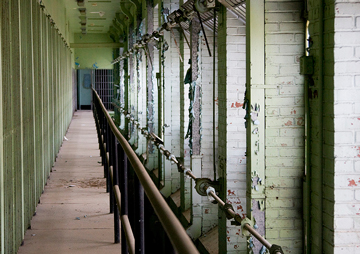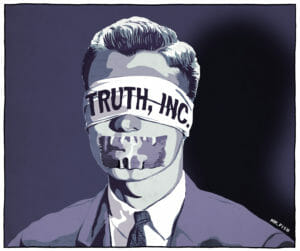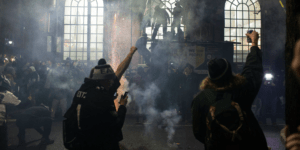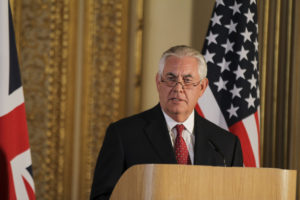Is the Fight to End Mass Incarceration Wasting Away in Washington?
What happened to that bipartisan push toward reform? Melissa Robison / CC BY-NC 2.0
Melissa Robison / CC BY-NC 2.0
By James Kilgore / AlterNet
This piece originally ran on AlterNet.
Mass incarceration’s profile as a national issue appears to be on the wane. Throughout 2015, the nation’s over-reliance on imprisonment drew a constant spotlight, producing a plethora of bipartisan policy proposals and expressions of moral outrage in Beltway circles. In March last year, Newt Gingrich and Democrat stalwart Van Jones co-hosted an unprecedented Washington, D.C. conference of nearly 500 key role players billed as a “Bipartisan Summit on Criminal Justice Reform.” The Koch Brothers Foundation teamed up with George Soros’ Open Society forces to sponsor it. Author and formerly incarcerated activist Shaka Senghor spoke, as did Georgia’s Republican governor Nathan Deal. At a moment of great congressional discord, people across the spectrum were finally agreeing on at least one thing: the U.S. was spending too much money on corrections and locking up too many people, especially black folks.
Activists added to the hype, pressuring presidential candidates in the early stages of the campaign. Movement for Black Lives leaders stressed the issue of mass incarceration in a widely shared conversation with Hillary Clinton. Black Lives Matter spokespeople interrupted Bernie Sanders’ speeches on two occasions, leading Sanders to add criminal justice reform to his talking points and to insert “racial justice” into his list of priorities. At the Senate level, Republican hopeful Rand Paul was co-sponsoring sentencing reform legislation with Cory Booker.
To top it off, President Obama visited a federal prison, and then released some 6,000 people from federal institutions in November. The Pope added fuel to the reform fire by dropping in on a Pennsylvania facility. The condemnation of mass incarceration and a new spirit of offering people with felony convictions a second chance was flowing from all quarters.
Yet as the presidential campaign heated up, mass incarceration began to fade from the scene. The bully in the presidential campaign playground, Donald Trump, contributed immensely to the change in climate. Posturing as the “law and order” candidate, Trump has stifled Republican reform discourse. At the Republican National Convention, he summed up his overall approach to criminal justice with one militant declaration: “The crime and violence that today afflicts our nation will soon—and I mean very soon—come to an end. Beginning on January 20, 2017, safety will be restored.”
With Trump’s rise, foot soldiers promising to “make America safe again” have come out of the woodwork to replace the bipartisan unity advocates. Milwaukee county sheriff David Clarke has become a one-man speaker’s bureau for renewed war on the streets. Wearing full dress uniform regalia, he opened his address to the RNC with a vow to make something “very clear”: “Blue lives matter in America.” Clarke went on to label Black Lives Matter and Occupy as forces of “social disorder” and “anarchy.” Clarke represents a growing police backlash trumpeting the myth of a reborn crime wave in the U.S. Both statistics and opinion poll findings provide at best minimal support for such claims. While violent crime rates did increase slightly in 2015, they have steadily declined during Obama’s years in office and are at much lower levels than in the early 1990s.
Moreover, Republican law-and-order fervor doesn’t reflect popular sentiments. Recent Gallup polls do show an increasing concern about crime and violence, but a July 13 survey revealed that only 6 percent of the population identified crime as the most important problem facing the country today. By comparison, 27 percent named “economic problems” as the number one priority. Ultimately, the resurgence of the law and order mantra may be less about about facts and figures and more about fanning the flames of fear, racism and xenophobia.
Whatever hope existed for promoting bipartisan unity on criminal justice at the RNC was in the end derailed by the committee of 112 tasked with finalizing the party platform. The 112 focused on condemning the Supreme Court for not opening the door to wider application of the death penalty and accused Attorney General Loretta Lynch of conducting a “campaign of harassment against police forces around the country.” While supporting some jail diversion programs like Drug Courts, their top priority for prisons was not closure or budget cuts, but making sure authorities “regain control of their correctional institutions, some of which have become ethnic and racial battlegrounds.”
Joining Trump and Clarke in leading the law and order charge was Newt Gingrich. Getting a whiff of a chance at the vice-presidential slot, Newt dropped reform talk and devoted his speech at the RNC to hymns of praise for Trump and condemning “radical Islamic terrorists.” In light of all of this along with “the centrality of Nixonian law and order” to Trump’s electoral vision, emeritus criminology professor Tony Platt told AlterNet, “it’s unclear right now if the campaign for modest federal reforms will continue.”
The Democrats
In contrast to the Republican about-face, the Democratic Convention opted for toning down their positions. While they brought the mothers of black people slain by police on stage, the calls in the platform to end mass incarceration, reform mandatory minimums and close private prisons (largely a product of the influence of the Bernie Sanders campaign) gained little air time compared to xenophobic patriotic appeals. In Clinton’s acceptance speech, the need to “reform our criminal justice system from end to end” was a throwaway, buried in a lengthy laundry list of promises on all issues. At the moment of realpolitik, ending mass incarceration has perhaps lost any capacity to attract new voters, especially whites who may be vacillating in their support for Trump.
Changes in Federal Laws
Election related party polarization has likely contributed to the lack of progress in advancing national legislation and policy change as well. The much-publicized Sentencing Reform and Corrections Act, jointly sponsored by a bipartisan cohort led by Republican Chuck Grassley and Democrat Cory Booker, has failed to make it to the congressional floor for a vote. The bill remains mired in disagreements over the depth and nature of acceptable change.
Another high-profile reform, the opening of presidential clemency petitions, has also made little progress. Obama’s decision to open the door to federal clemency petitions prompted more than 12,000 applications. However, to date only 562 have been granted. The lack of administrative resources to review the often complicated documents means the bulk of those remaining may be rolled over to the next presidency. Moreover, Obama rejected the more powerful option of applying a blanket amnesty to certain categories of convictions like the notoriously anti-black crack cocaine laws. In the 1970s, Presidents Ford and Carter applied blanket amnesties to those who dodged the draft.
A final glitch in the reform process has hit the realm of immigration. While the president made major advances with the DACA and DAPA measures to delay deportations, in 2016 things have taken a serious turn for the worse. A June Supreme Court decision virtually overturned DAPA, thus putting another five million undocumented adults back onto the hit list for possible deportation.
To make matters worse, Immigrations and Customs Enforcement has begun a new offense of roundups. From across the country, reports have emerged of ICE agents showing up at unexpected places—courthouses, probation offices, workplaces—to drag away those without proper papers. Investigative journalist Brian Dolinar, who covers these issues in the Midwest, reports to AlterNet that there have been more than 50 ICE raids alone in Champaign-Urbana, Illinois, a liberal college town of 120,000. He adds that such raids are “taking place all over the country, not just along the border, but they are happening under the radar with little or no media coverage.”
The Brighter Side
While at the federal level things may have slowed, a few important changes continue to take place where it really matters: at the state and local levels. Although the federal policies and debates attract the most media attention, state prisons and county jails hold nearly 90 percent of those incarcerated. Ultimately, most reforms at the federal level have little impact on states and counties, save to set an example of possible changes.
The most noteworthy advances have been the slashing prison populations in key states. New York, New Jersey, California and Rhode Island have reduced their prison populations by more than 20 percent in the last seven years. The decarceration formula has varied. New York’s reductions were largely driven by a cutback in drug prosecutions, while California’s decrease came about as a result of a federal court order. But these states are not alone. In 2014, Mississippi, using a combination of sentencing and parole reform, reduced its prison population by 14.5 percent in one year. Moreover, since 2000, at least 29 states have passed laws to reduce mandatory minimums. More than 30 such measures have been signed into law in the past six years. Despite the slow advance of national legislation, the federal prison population finally began to show a decline on 2013 after more than 35 years of growth. Obama’s November 2015 release contributed to a fall in federal prison populations of 16,000 (about 8 percent) in the last 19 months.
Outside the legislative sphere, national efforts via a number of non-government initiatives have kept things moving. These have included longstanding campaigns like Ban the Box, initiated largely by organizations of formerly incarcerated people like All of Us or None and efforts by the National Juvenile Justice Network to end juvenile life sentences without parole. New initiatives and organizations continue to appear with groups like the National Council for Incarcerated and Formerly Incarcerated Women focusing on the much-neglected 700percent expansion of the population in women’s prisons over the last two and a half decades.
Foundations and professional organizations have stepped in to fund reform as well. The Annie E. Casey foundation is supporting alternatives to incarceration for juveniles, and the Pre-Trial Institute is coordinating efforts to restructure pre-trial regimes, especially in regard to cash bail. Efforts to restructure local criminal justice practice aimed at reducing prison and jail populations have drawn tens of millions in support from the ACLU and the Macarthur Foundation.
Yet while these pockets of change and funding flows hold out promise, the total decrease in prison population nationally from 2009 to 2014 was only about 52,000—just over 2 percent. Ultimately, to totally reverse the forces of mass incarceration requires not only legislative change and finance, but the presence of a coordinated and focused mass social movement. The roots of such a movement have appeared over the past two years in the mobilizations in response police killings of black people. Elements of the youthful supporters of Bernie Sanders’ “political revolution” also represent such a potential force, though it remains to be seen what direction they will take post Hillary’s nomination.
Some activists argue that these efforts, especially those focused on police killings, need to broaden their scope to a more systemic perspective or run the risk of being confined to limited reforms such as body cams, community review board initiatives, or racial awareness training. The failure to successfully prosecute Darren Wilson in Ferguson and the perpetrators in the Freddie Gray case highlights the obstacles to investing too much faith in existing political processes. Gus Wood, an Illinois-based activist and PhD candidate, has studied policing extensively. He told AlterNet that “as we attempt to transform this current moment to an actual social movement, we must incorporate a systemic racial class analysis so that we can attack the various forms of racial oppression, like wage/income disparity, hypersegregation/apartheid, state-sponsored violence, imperialism, and mass incarceration. Our resistance must match the complexity of our oppression.”
“A Vision for Black Lives,” a set of policy documents released August 1 by the Movement for Black Lives reflects the kinds of systemic thinking highlighted by Wood. The expanded directions put forward by the “Movement” take protest against police violence well beyond minor tweakings of police practice and attitudes. Situating police violence in the context of the historical and global oppression of black people, these documents call for reparations, international solidarity and economic justice while remaining true to the prioritization of leadership of queer and transgender people. More than 50 organizations, including Black Lives Matter Network, took part in formulating the contents.
Michelle Alexander, author of The New Jim Crow, echoed such sentiments in responding to the deaths of Alton Sterling and Philando Castile. In a recent Facebook posting, she declared: “I no longer believe that we can ‘fix’ the police, as though the police are anything other than a mirror reflecting back to us the true nature of our democracy. We cannot ‘fix’ the police without a revolution of values and radical change to the basic structure of our society… There’s an unfinished revolution waiting to be won.”
Ultimately, the momentum for criminal justice reform, let alone the type transformative change needed to reverse mass incarceration, remains far from achieving the intensity of the conservative “lock ’em up and throw away the key” mania that grew the system in the 1980s and ’90s. As we draw nearer to election day, concerns about excessive imprisonment and bloated corrections budgets are likely to fade further into the shadows behind political candidates’ efforts to malign their opponents’ character and cast themselves as the true patriots. That unfinished revolution of which Michelle Alexander speaks still waits to be won.
Your support matters…Independent journalism is under threat and overshadowed by heavily funded mainstream media.
You can help level the playing field. Become a member.
Your tax-deductible contribution keeps us digging beneath the headlines to give you thought-provoking, investigative reporting and analysis that unearths what's really happening- without compromise.
Give today to support our courageous, independent journalists.






You need to be a supporter to comment.
There are currently no responses to this article.
Be the first to respond.